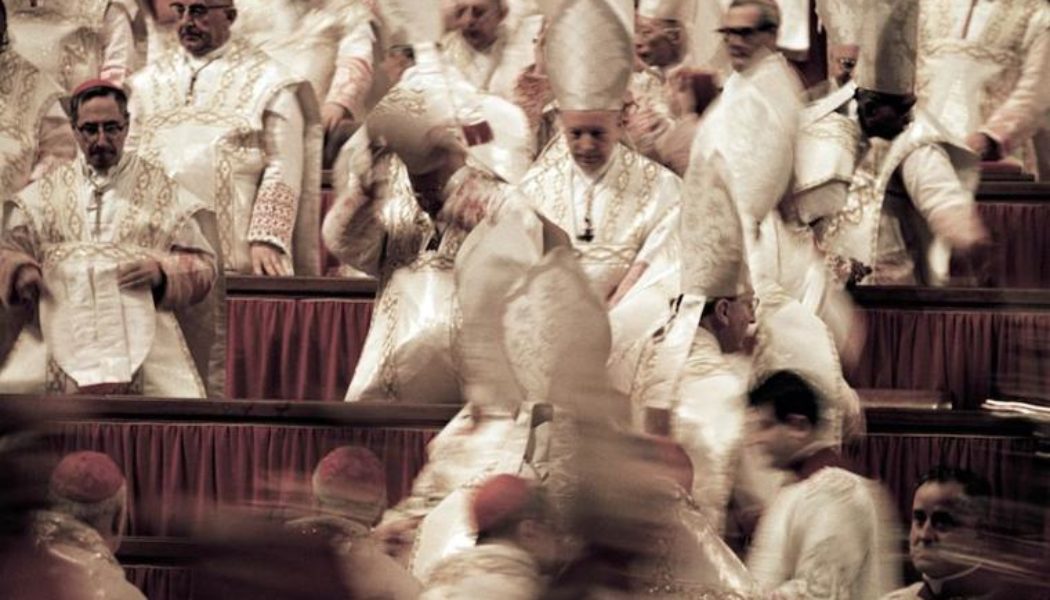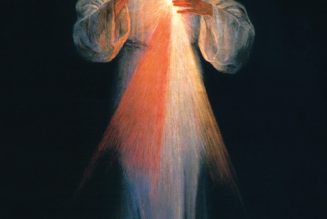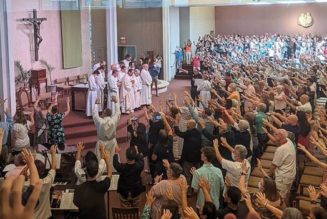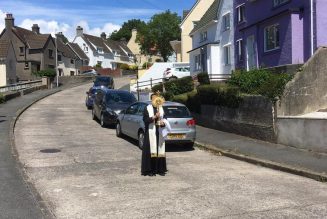
One of the assumptions that seems to animate so many of the conversations surrounding a more synodal Church is that a more “democratized” Catholic Church is by definition a better Church. To that end, we saw in last year’s Synod on Synodality that there was a lot of chatter about a Church that listens to “the people of God.” And those two concepts — a democratized Church and the Church as the people of God — were often conflated to mean almost the same thing.
I think that this conflation is incorrect and that the “people of God” metaphor, used in Lumen Gentium, when properly understood not only does not endorse a more democratic Church but actually implies the opposite.
Whenever I saw the “people of God” metaphor referenced in the lead-up to the first part of the Synod on Synodality, I was reminded of the words of the character Indigo Montoya in the movie The Princess Bride: “You keep on using that word. I do not think it means what you think it does.” Indeed, the synodal leaders resurrected a long-dead interpretation of the people of God metaphor, popular among liberal theologians in the ’70s, to denote the laity as opposed to the hierarchy, with that mistake compounded by a related one, where a distinction was made between “the institutional Church” (a tiresome and oppressive oligarchy of old celibate men) and “the Church of the people” (a liberating wonderland of “real people”).
Therefore, it was concluded back then, and apparently today again, that the Church is in desperate need of democratization and this is to be achieved by empowering the “people of God” in a vague egalitarianism of magically renewed structures.
By contrast, in Chapter 2 of Lumen Gentium (the Second Vatican Council’s dogmatic constitution on the Church) the “people of God” motif was not used to distinguish between the laity and the hierarchy, but rather to unite them under a single, overarching theological concept (9-17). The conciliar usage of the metaphor, though novel in modern Catholicism, harkened back to the Church fathers who wanted to emphasize that all Christians — laity, religious and hierarchy together — were all “pilgrims” and “sojourners” in this world. We are all sinners in need of grace and we are all looking to the horizon for Our Lord’s return. We are all the people of God and it is not at all synonymous with “the laity.”
The emphasis therefore was not on some democratic notion of a “people” seen as a mere political polity standing over and against their “rulers”. The emphasis instead is theological and eschatological. This ‘people of God’ is the completion and fulfilment of Israel and is therefore the assembly (ekklesia) of those saved and called by Christ the Head. We are all, therefore, as Lumen Gentium says, a “messianic people” who are living in messianic times, which is a time characterized by the “in betweenness” of a Kingdom already present but not yet fulfilled.
It is instructive that chapter one of Lumen Gentium begins with a description of the Church as a “Mystery” in the strict sense since it is the sacrament of the presence of the Trinitarian life of God in the world.
The Church is constituted as a sacramental reality and its entire existence is grounded first and foremost in this “vertical” relationship with God. And as such the Church is also inherently hierarchical. And it is only after establishing this fundamentally sacramental and vertical constitution of the Church does Lumen Gentium discuss the Church as a pilgrim people of God. In other words, this “people” is only what it is in virtue of baptism and inclusion in Christ’s body. There is no hint here, therefore, of the Church as a mere voluntary society of like-minded people who come together in order to celebrate their like-mindedness and to establish a kind of ecclesial polity grounded in the sheer power of their collective wills.
The key point here is the conciliar resistance to a sociological reduction of the Church to the categories of the “right” and the “left.” For example, the older, traditional theology of the Church as a “perfect society” is most definitely true, but only in the sense that it is eschatologically and christologically underwritten as the true possessor of all the means of salvation.
Sadly, the perfect society motif had been distorted from this christological sense into a worldly socio-political reality where the laity and the hierarchy were separated as “the rulers and the ruled,” and where the counsels of perfection (poverty, chastity and obedience) were the special reserve for the Church’s clerical elites, with the laity consigned to living a minimalistic form of Christian existence within the boundaries of the moral commandments larded with casuistical gerrymandering. The whole edifice became an ossified and sclerotic forensic exercise in “following the rules established by our rulers.”
This is the reality against which the Council was kicking which helps us also to contextualize within this eschatological and sacramental sense of the people of God the further conciliar teaching on the universal priesthood of all the faithful and the universal call to holiness. None of it has to do with “democratizing” the Church or reducing her inner constitutive core as a participation in the Trinitarian life to a drab set of hackneyed political categories about “participatory management styles” and the like.
Christ is the head. All vocations, ministries, charisms, sacraments, offices and so on, are mere participations in the absolute nature of those realities in Christ. And the nature of the participation will differ depending on one’s state of life.
But this conciliar vision of the people of God metaphor also resists the sociological reduction of the Church so common among liberal Catholics, especially with regard to those who wish to impose a congregational and so-called “democratic” model upon the Church, as we see clearly today in the German Synodal Way’s call for a permanent council of mostly laypeople as the chief governing structure in the Church in place of the authority of the bishop.
Typical of this ecclesiology is an explosion of bureaucracy and of the endless proliferation of committees. Personal repentance and the pursuit of holiness as the core of the Church are downplayed in favor of the “reform” of “structures” and “processes”. In this model the Church is not so much an incubator of saints as it is the progenitor of ever-novel “initiatives.”
The Australian theologian Tracey Rowland, winner of the Ratzinger Prize in theology, has a brilliant article on this very topic in the latest issue of the journal Communio entitled, “Joseph Ratzinger on Democracy within the Church.” Space precludes a full analysis of this important and insightful article, so I want to focus on some quotes from Joseph Ratzinger she highlights on the topic of the bureaucratization of the Church as a co-morbidity that always shows up when people attempt to “democratize” the Church.
With regard to the bureaucratizing of the Church Rowland quotes Ratzinger: “I have said very often that I think we have too much bureaucracy. … Everything should not take place by way of committees; there must also be the personal encounter.”
This latter point is key for Ratzinger since it is only the encounter with Christ that preserves our true freedom in the Church, since if we are all so bound to one another by first being bound to Christ, then all are equal in that regard and all are protected from the tyranny of misguided majorities. And therein is the irony.
The more the Church speaks of democratization, and the more it pursues “inclusion and participation for the people of God,” and the more it doubles-down on its ill-defined and vague “synodalism” as a cipher for “enacting the curve of history via committees,” then look out. True ecclesial freedom is about to be the nullified in the name of “the people” — a people whose alleged “experiences” coincide with the aims of the ecclesial elites and are thus counted as of more importance than the “false consciousness” of those who adhere to Christ first.
As Rowland notes, “There is a sociological phenomenon that the philosopher Alasdair MacIntyre is famous for highlighting: while Marxist tradition purports to foster human freedom, in every real … Marxist state, human freedom has been suffocated by the apparatus of the state, that is by bureaucracies.”
So, too, here in the modern Church. What is at stake are two rival ecclesiologies: One is grounded in Christ and is sacramental, hierarchical, and self-consciously oriented to our supernatural end in God. The other is grounded in the spirit of the world and is self-consciously reductive and oriented to purely immanentist projects of earthly achievement. The former leads to true freedom and therefore the truest democracy. The latter is latently totalitarian.
In this regard I can do no better than to end with another quote from Pope Benedict cited by Rowland:
“The Church cannot conceptualize for herself how she wants to be ordered. She can only try to understand ever more clearly the inner call of faith, and to live from faith. She does not need the majority principle, which always has something atrocious about it: the subordinated part must bend to the decision of the majority. … But in the Church the binding to the faith protects all of us: each is bound to faith, and in this respect the sacramental order guarantees more freedom than could be given by those who would subject the Church to the majority principle.”








